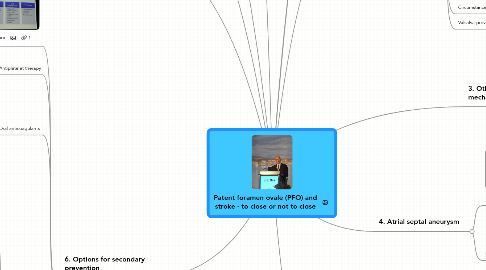
1. 6. Options for secondary prevention
1.1. picture
1.2. Antiplatelet therapy
1.2.1. reduce recurrent ischemic events in the generality of ischaemic stroke survivors
1.2.2. well-tolerated
1.3. Oral anticoagulants
1.3.1. 7. PICCS study
1.3.1.1. Reference
1.3.1.1.1. Homma et al, circulation 2002
1.3.1.2. picture
1.4. PFO closure
1.4.1. picture
1.4.1.1. picture
1.4.2. references
1.4.2.1. Wohrle,lancet 2006
1.4.2.1.1. http://www.ncbi.nlm.nih.gov/pubmed/16876648
1.4.2.2. MIST 20008
1.4.2.3. NMT Medical Announces Preliminary Results of CLOSURE I
1.4.2.3.1. press release
1.4.3. Drawbacks of PFO closure
1.4.3.1. is not relevant if a PFO-unrelated mechanism is the cause of stroke
1.4.3.2. offers a false assurance and may lead to less incentive to comply wiht secondary prevention recommendations
1.4.3.3. doesn't avoid the need for long-term medical therapy
1.4.3.4. doesn't guarantee shunt closure
1.4.3.5. doesn't prevent thrombo-embolism
1.4.4. Does PFO closure reduce stroke recurrence?
1.4.4.1. Series of transcatheter PFO closure
1.4.4.2. Nonrandomised comparisons of PFO closure with medical treatment
1.5. CLOSE RCT
1.5.1. picture
2. 7. Our curent practice
2.1. Antiplatelet therapy
2.2. Oral anticoagulants
2.3. PFO closure
2.3.1. recurrent ischemic event despite optimal antithrombotic therapy
2.4. picture
3. 8. Take home message
3.1. picture
4. Author of presentation
4.1. J.L. Mas
4.2. http://www.ncbi.nlm.nih.gov/sites/entrez?db=pubmed&cmd=DetailsSearch&term=Mas+jl[Author]
5. Navigation
5.1. Next presentation on Stroke and Seizures
5.2. Main EFNS presentation overview:
6. 1. PFO and stroke a meta-analysis of case-control studies
6.1. Alsheikh-Ali et al, Stroke 2009
6.1.1. http://www.ncbi.nlm.nih.gov/pubmed/19443800
6.2. Picture
6.2.1. Cryptogenic stroke vs stroke of dtermined cause
6.2.2. Cryptogenic stroke vs controls without stroke
7. picture
7.1. picture
7.1.1. picture
8. 5. Risk of stroke recurrence
8.1. picture
8.2. List of reviews
8.3. Mas et al NEJM 2001
8.3.1. PFO-ASA study
8.3.2. http://www.ncbi.nlm.nih.gov/pubmed/11742048
9. 2. Is stroke due to paradoxical embolism?
9.1. picture
9.1.1. picture
9.2. reference
9.2.1. Halperin and fuster
9.3. Proven
9.3.1. presence of thrombus within an intracardiac defect at autopsy or echocardiography
9.4. Presumed
9.4.1. Arterial embolism with no evidence of left sided circulation source
9.4.2. Venous thrombosis and or pulmonary embolism
9.4.3. Elevation of the right heart pressure, sustained or transitory (Valsalva's maneuver)
9.5. Venous thrombosis
9.5.1. Low rate of DVT in most studies
9.5.2. Pelvic vein thrombosis
9.6. Hypercoagulable state
9.6.1. G20210A, factor V Leiden mutation
9.7. Circumstances predisposing to DVT
9.7.1. prolonged immobility
9.8. Valsalva-provoking activity
10. 3. Other potential stroke mechanisms
10.1. picture
10.2. paroxysmal Atrial fibrillation
10.3. Direct embolisation from thrombi formed locally in the PFO tunnel or in the ASA
10.4. Occult stroke cause associated with PFO
10.5. etc.. see pic
11. 4. Atrial septal aneurysm
11.1. picture
11.2. Reference
11.2.1. Handke et al, NEJM 2007
11.2.1.1. http://www.ncbi.nlm.nih.gov/pubmed/18046029
11.2.2. Goel et al Am J Cardiol 2009
11.2.2.1. picture
11.2.2.2. http://www.ncbi.nlm.nih.gov/pubmed/19101242
